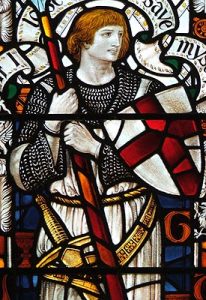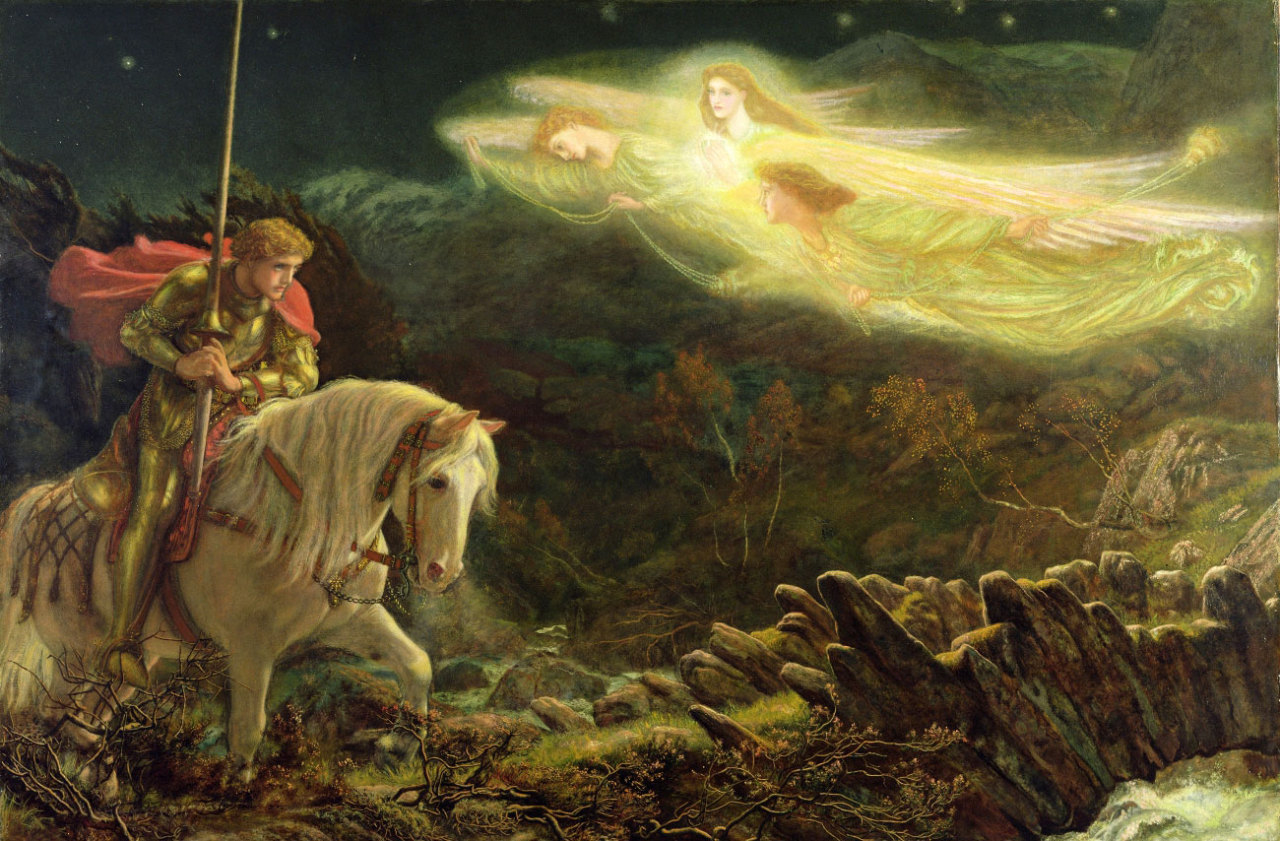In Arthurian Romance, the mysterious wizard Merlin prophesized to King Uther Pendragon that a noble youth named Galahad would soon be born, who would then save the Kingdom from evil and usher in a state of blessedness. Sure enough, in due time, the child was born of dubious parentage. Despite having grown up shielded from knowledge of the world by his mother, Galahad believed his destiny was to become a knight.
Travelling to seek his fortune, Galahad came across a riverbed. There he saw a stone with a fabled sword embedded within. He took hold of the sword and drew it out with ease. This marvel was observed by some of King Arthur’s knights, and soon after hearing the story told by his knights King Arthur dubbed Galahad as Sir Galahad at his famous Round Table.
Galahad was seated at The Siege Perilous, the long-empty seat fraught with danger awaiting the knight perfect in courage, morality, gentleness, chivalry and courtesy. Sir Galahad was then awarded a marvelous shield of white, symbolizing purity, upon which Joseph of Arimathea marked a vermillion cross in blood.

Credit: Arthur Hughes
Later, Sir Galahad and two other knights were dispatched on the quest for “The Holy Grail,” the chalice brought to England by Joseph of Arimathea. After many trials, the three successfully located the Grail, but only Sir Galahad was allowed to see it. This was because he had shown that only he had the strength and purity of heart to overcome evil and remain unsullied. He was then rewarded with immortality.
All the highly trained and practised knights of Arthurian Romance, appropriately armoured and bearing lances, swords and shields in the performance of their duties, were expected to rescue damsels in distress, to slay dragons wherever encountered, and to always do the right thing. Sir Galahad, being their role model, always sought to “shield” and defend those in need of emergency assistance. Among the Franks on the continent, at Charlemagne’s court, the twelve Paladins were tasked to perform these duties.
In the modern world, there is no shortage of those in need of emergency assistance. Who better in this modern world to symbolize with the shield of the perfect knight than those exemplary dedicated modern knights and paladins with their panoply of life-saving skills and tools: our First Responders?
Under the English Common Law system (currently the system of law practised in Commonwealth countries, former British colonies and the U.S.) Law and Equity are recognized as distinct bodies of law. The two are said to run in parallel and equal channels.
Justice is often symbolized by a sword accompanied by a pair of scales, signifying a due process of a fair hearing before the awful sword of Justice is brought to bear. Equity, then, was developed to ensure that fairness and balance was applied to mitigate the sometimes-harsh results of the application of the law.
After formalizing through “Judicature Acts” in various jurisdictions, Equity now governs branches of the law such as the law of Trusts; Fiduciary law; Estoppel; relief against penalties and forfeitures; contribution, subrogation, set-off and unjust enrichment.
For example, a case developed in Eastern Ontario where the husband had owned and run an apple orchard while his wife had run beehives whose bees pollinated the apple trees and whose honey sales had created profits added to the family wealth. The judges in Equity found a constructive trust and the husband was made to share the proceeds from the sale of his land.
Thus, Equity means fairness. And Equity must always be used as a shield, and never as a sword. So, the Shield of Equity must join the Sword and Scales of Justice as symbols of the highest laws of Canada, equality and impartiality before the law, and a badge of the true spirit of Canadian Justice. Thus, First Responders apply their arts and skills equitably to victims and patients without fear or favour.
***
Featured Photo Credit: David Nash Ford’s Early British Kingdoms: Sir Galahad


